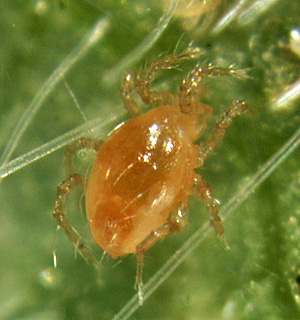
Mites are amongst the smallest of all members of the Animal Kingdom. Although they are incredibly abundant we rarely see them because most are under 1 mm (1/25th inch) long; some are much smaller than that. Mites comprise a very large group; scientists estimate that there may be as many as a million different types, but so far only about 50,000 have been identified and named. Many of these are species that are important to humans in one way or another.
Mites are arthropods, meaning that they have a hardened exoskeleton (outer skin) and jointed appendages. Within the arthropods, they are distantly related to insects, but more closely related to spiders and scorpions, with which they form the group we call arachnids.
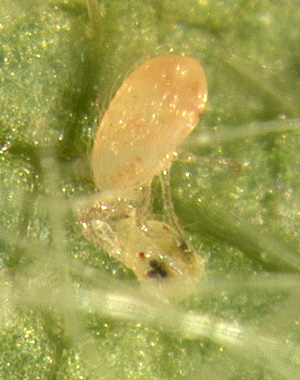
Mites have very diverse biologies. Many live in the soil where they feed on microorganisms, fungi, or dead organic matter, or where they prey on other mites, small insects and even nematodes. Others occur in the water where they have similar diverse habits. Gardeners are familiar with those that feed on plants, such as the many species of spider mites or “red spiders”, as well as the gall mites such as those that make the various lumps, bumps, and felty patches on plant leaves. Many mites are parasitic on insects or higher animals such as birds, reptiles, and mammals. Ticks, including both the wood tick and deer tick, also belong to the mite group (Subclass Acari).
Mites also provide beneficial services. For example, they are very helpful in the degradation of dead organic matter and therefore play an important role in nutrient recycling. But the group of interest here are the mites that hunt down, kill, and eat various pests of our gardens, landscapes, and ornamental plants. These predatory species, even though they are very tiny and usually overlooked, occur in virtually every landscape and are incredibly important in the natural control and biological control of certain types of plant pests.
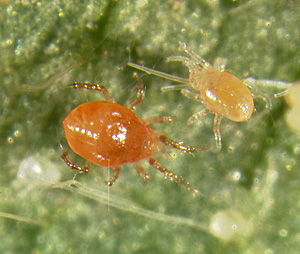
The most important group of mites that are predatory on plant-feeding mites is the family Phytoseiidae, with over 2200 known species around the world. There is no common name for this family of mites or any of its members – they are usually just referred to as phytoseiid (fy-toe-see-id) mites based on the scientific name of the family. Although they are sometimes called “predatory mites” this can be a bit misleading as there are many other families of mites that are also predatory.
Almost all phytoseiid mites live on plants. They occur in virtually all plant habitats but they tend to be more uniformly present in perennial (undisturbed) habitats rather than areas that are cultivated regularly. This is because their small size means they don’t move great distances very fast. In the home garden they are more likely to be seen on roses or apple trees instead of radish plants or marigolds, especially earlier in the growing season. They occur commonly in perennial agricultural commodities such as orchards, vineyards, and forests.
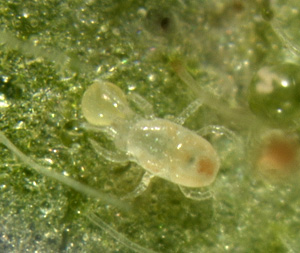
Like most mites, phytoseiids are very tiny, in the range of about ½ mm (1/50 of an inch – about the size of the period at the end of this sentence). Because of this, they feed on very small prey. Probably the most important prey of most species includes other types of mites. They readily feed on spider mites, gall mites, and other types of mites that are plant pests. They also feed on tiny insects, insect eggs, and other tiny arthropods. Amongst insects, they feed on the young crawler stage of scale insects and young thrips, for example.
Phytoseiids are a natural and common component of all healthy gardens. They are helping in pest management throughout the growing season. There are also ways we can help them do a better job for us. When we make conscious decisions to use the beneficial “natural enemies” of pests, we are practicing what is known as biological control. The following are three types of approaches for using predatory mites in the garden or landscape.
- Providing required resources. Like all living organisms, predatory mites require certain resources in order to survive. Chief among these are water, food, and a stable habitat. Water is usually easy to acquire from our rains and morning dews. Moisture is also acquired when they eat their prey. Some predatory mites are highly specialized as to what they will eat; for example, some species eat only plant-feeding mites. Others may be strictly predatory but have a more varied diet that can include tiny insects. Still other species can also gain nourishment from other types of food, such as fungi and pollen. The populations of these types tend to be more stable in a diverse landscape (many plant species) because they can usually find some sort of maintenance food to carry them through times when prey (pests) are less abundant. Having a stable habitat is also very important to these tiny creatures. Because they do not fly and must move from location to location by walking, it is difficult for them to repopulate areas that are greatly disturbed (such as a vegetable garden or a bed of annual flowers). Areas of herbaceous or woody perennials are ideal habitats for predatory mites.
- Avoiding broad spectrum insecticides. Many plant feeding mites are notoriously difficult to control with conventional insecticides. But unlike their plant-feeding relatives, predatory mites tend to be particularly susceptible to many broad spectrum insecticides. It is not unusual to see an outbreak of pest mites in those areas that receive treatment (or, especially, multiple treatments) of broad spectrum materials because the predatory mites were eliminated by these sprays. Common garden insecticides that are notoriously hard on predatory mites include active ingredients such as acephate, bifenthrin, carbaryl, cyfluthrin, cypermethrin, deltamethrin, dimethoate, esfenvalerate, lambda-cyhalothrin, malathion, and permethrin. (Note that you often have to look at the fine print under “active ingredients” to find these chemical names.) Even some “natural” and “organic” types of insecticides may be harmful to predatory mites, especially at the time of application. It is very difficult to grow some garden plants in some locations without using insecticides, so, by necessity, there may be some negative impacts on predatory mites and predatory insects. Whenever possible, insecticides should be used only when necessary because of historical or actual pest problems. They should be used only when pests are actually present and only on infested plants. In this way, the population of predatory mites will be as healthy as possible.
- Purchase and release of predatory mites. Several species of predatory mites are mass-produced and sold commercially. These are mostly used to control pest mites. They work best if you release these predators when the pest mite populations are still low; it is difficult for biological control to catch up with a large, damaging population of pest mites. If you have plants that are routinely attacked by spider mites (such as roses or fruit trees, or even annual crops such as marigolds) a release of predatory mites early in the growing season may result in season-long control. However, such releases are not permanent – they need to be repeated in the following year. In addition to feeding on plant-feeding mites, some commercially available phytoseiid mites are effective predators of thrips. One environment where pests such as spider mites and thrips are notoriously bad is the greenhouse. Predatory mites work quite well in greenhouses as long as the humidity is moderate to high and as long as plants are in contact so that the mites can travel from one plant to another while they are searching for prey.
Stratiolaelaps scimitus (formerly Hypoaspis miles) is not a phytoseiid mite, but is a predator from a related family, the Laelapidae. Stratiolaelaps is an effective predator of the eggs and larvae of fungus gnats, which are often problems in organic soils used for greenhouse plants and house plants.

There are many companies that sell predatory mites. Shipments arrive in temperature-controlled containers and contents are guaranteed to arrive alive. To find sources of predatory mites, type “predator mite” into your internet search engine; several commercial sources should be listed.
In summary, tiny predatory mites occur in our gardens as well as virtually all plant habitats world-wide. They are effective predators of plant feeding mites and tiny pest insects. Although they do occur naturally in gardens, their benefits can be increased if we resist using broad spectrum insecticides until they are absolutely needed. For some pest situations, it may be worthwhile to purchase and release predatory mites.
Information on specific products is provided as a service and is not meant to endorse one product over similar products. Remember that pesticide labels are legal documents; any uses not specifically indicated on the label are illegal and may be harmful to people or the environment.
– Dan Mahr, University of Wisconsin – Madison, Department of Entomology
All photos by Merritt Singleton, University of Wisconsin – Madison, Dept. of Entomology
February, 2025





 Silver Leaf
Silver Leaf Red Star Rust
Red Star Rust Tree Species Recommended for Fall Planting
Tree Species Recommended for Fall Planting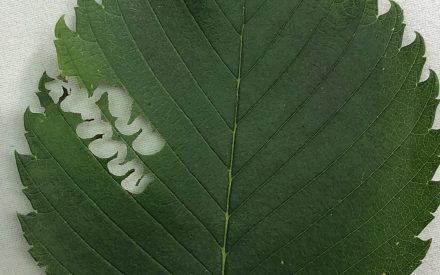 Elm Zigzag Sawfly
Elm Zigzag Sawfly


